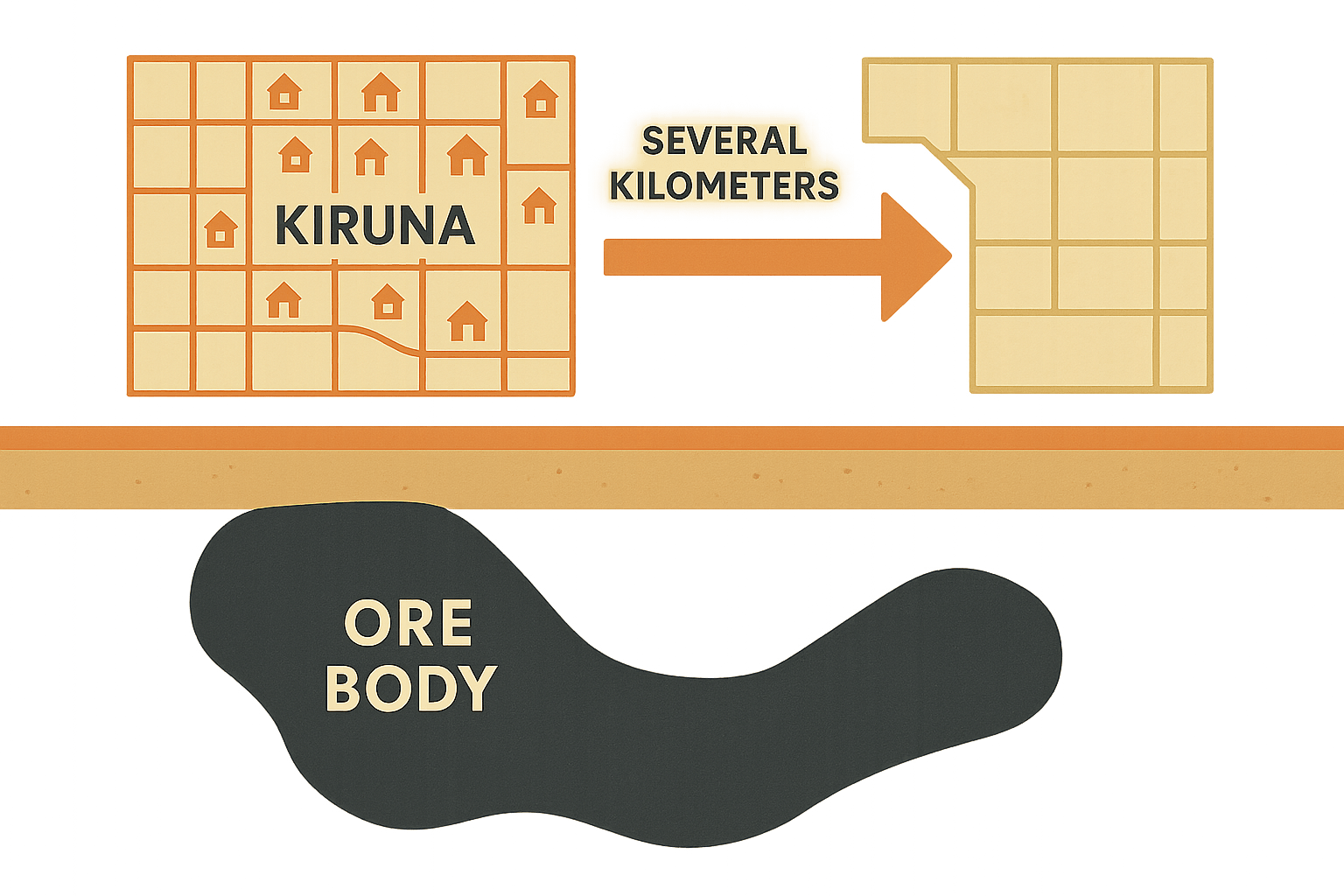Imagine waking up one morning to a construction crew not building a new road, but preparing to lift your entire apartment block onto a giant truck. Imagine watching your historic church, a century-old icon, slowly inching its way down the street to a new location three kilometres away. This isn’t a scene from a fantastical film; it’s the lived reality for the 23,000 residents of Kiruna, Sweden, a city engaged in one of the most ambitious and surreal urban relocation projects in modern history.
Nestled 145 kilometres (90 miles) north of the Arctic Circle, Kiruna’s story is a fascinating drama written on the landscape itself—a tale of physical geography dictating the fate of human geography.
The Iron Mountain and the Cracking Ground
To understand why a city is moving, you must first look beneath it. Kiruna exists for one reason: the Kiirunavaara, one of the world’s largest and purest underground iron ore deposits. This massive, slanted slab of magnetite, stretching four kilometres long and dipping over two kilometres into the Earth’s crust, is the economic heart of the region and a cornerstone of Sweden’s national wealth.
The state-owned mining company, LKAB (Luossavaara-Kiirunavaara Aktiebolag), has been mining this ore body for over a century. The problem lies in their highly efficient mining method: sub-level caving. Miners blast ore deep underground, and as the caverns are emptied, the rock and earth above collapses and compacts downward to fill the void. For decades, this process occurred at a safe distance from the town. But as the mine has chased the ore body deeper and deeper—now reaching depths of over 1,365 meters—the deformation zone on the surface has begun to spread, creeping directly under Kiruna’s city centre.
The ground isn’t just sinking; it’s cracking, splitting, and becoming dangerously unstable. Fissures appear in roads, and building foundations are compromised. The very resource that birthed Kiruna is now threatening to swallow it whole. The city had a choice: let the mine die, or move the town.
Stadsomvandlingen: The Great Urban Transformation
The decision was made to move. The project, known as Stadsomvandlingen (“The Urban Transformation”), is a staggering undertaking in logistics, engineering, and urban planning. The plan is to shift the city centre approximately three kilometres to the east, a process scheduled to take decades and cost billions.
This is not simply a case of abandoning the old and building the new. While many buildings are being demolished and reconstructed, some of Kiruna’s most architecturally and culturally significant structures are being preserved and physically moved. The most famous example is the Kiruna Church. Completed in 1912 and voted Sweden’s most beautiful public building, this stunning wooden structure was carefully separated from its foundation, jacked up, placed on self-propelled modular transporters, and painstakingly driven to its new home in 2025.
The challenges of this arctic relocation are immense:
- Harsh Climate: The subarctic environment offers a very short and intense construction season. Work must be planned around long, dark winters with heavy snowfall and temperatures that can plummet below -20°C (-4°F).
- Geotechnical Stability: The new city is being built on land that must be thoroughly vetted to ensure it is stable and not susceptible to future mining-related subsidence.
- Infrastructure Overhaul: It’s not just buildings. Every piece of urban infrastructure—water mains, sewage systems, electrical grids, and roads—must be laid anew and connected, all while the old city remains functional.
A Case Study in Power, Place, and People
The Kiruna move is a textbook case of political and economic geography in action. LKAB is 100% owned by the Swedish state. This isn’t a private corporation strong-arming a local community; it’s a decision where national economic interest and local community existence are fused. The iron ore from Kiruna is vital for Sweden’s export economy and is now being marketed as a key component for “green steel”, essential for the global energy transition.
This creates a complex and sometimes fraught relationship. LKAB is funding the entire move, offering residents a new home in the new city or the market value of their old one plus 25%. On paper, it’s a fair deal. But it raises profound questions about the nature of “place” and “home.” How do you compensate someone for the loss of a neighbourhood where generations of their family have lived? How do you replicate the social fabric of a community, the familiar walk to a friend’s house, the view from a window?
Furthermore, the mine’s expansion has significant implications for the region’s indigenous Sámi population. The vast industrial footprint of the mine and its associated infrastructure disrupts traditional reindeer herding corridors, which are vital to Sámi culture and livelihood. This adds another layer of human-environment conflict, pitting national economic strategy against indigenous land rights in the sensitive Arctic landscape.
The Future City on the Permafrost
The new Kiruna is taking shape as a denser, more modern, and more sustainable city. The architects and planners aim to create a vibrant centre that corrects some of the perceived flaws of the old, sprawling town. But the question remains: will it feel like home?
Kiruna’s story isn’t just about Sweden. It’s a potential harbinger of the future for resource-dependent communities worldwide. As the global demand for minerals continues to surge—for everything from smartphones to electric vehicles and wind turbines—extraction will push into more remote and challenging environments. The extreme measures being taken in Kiruna could become a blueprint, or a cautionary tale, for others.
Ultimately, Kiruna remains a geographical paradox: a city being meticulously unmade and remade by the same force that gave it life. It is a living laboratory for urban geography, a monument to arctic engineering, and a stark reminder that on our planet, sometimes even the ground beneath our feet is not guaranteed.
